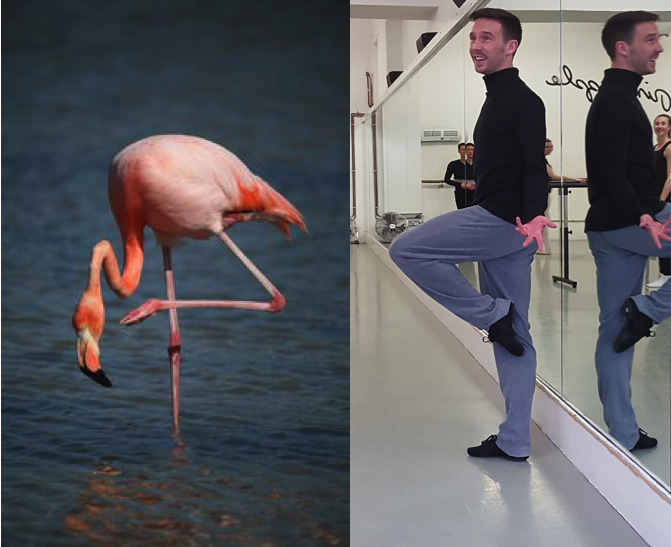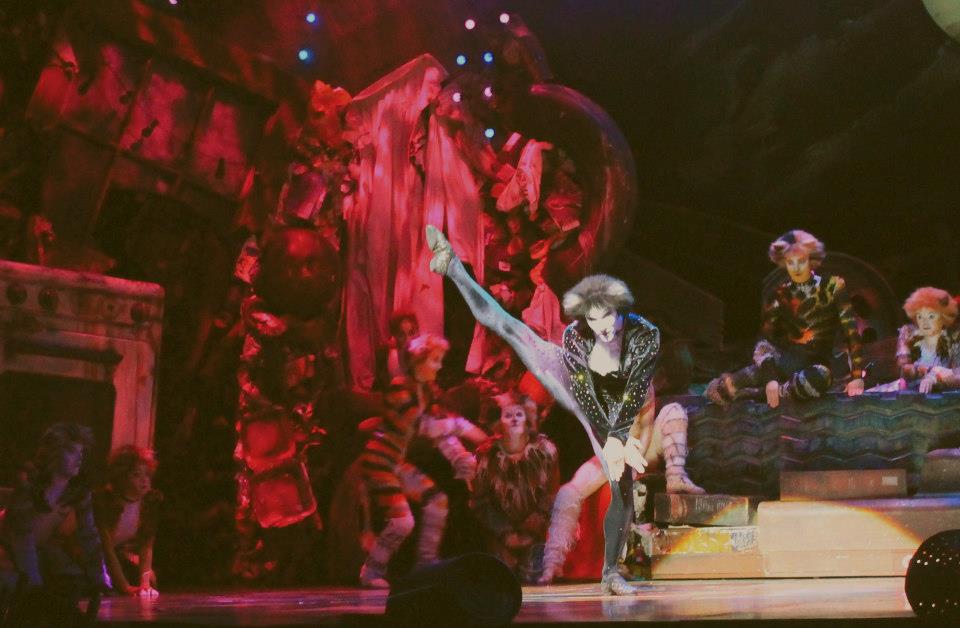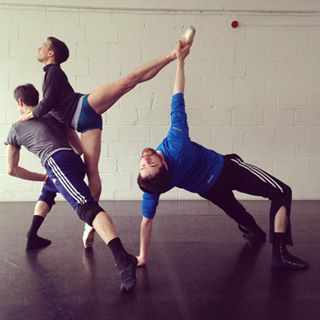
As his dancing career evolves into teaching, Joel Morris tells us his heart is split between stage and ballet studio.
Just after 6 o’clock on a Thursday evening beginners class at Pineapple is in full flow. Sixteen adults stand at the barre, oozing concentration, hanging from Joel Morris’ every word.
He paces the room attentive to each individual. Encourages them. Wills them on.
“Very nice!” “Find your balance.” “Keep your weight forward.”
Sometimes more of an explanation is required. As for retiré.
He asks them to “think flamingo.”
“There’s nothing more amazing than flamingos. They stand in retiré all day.”

“And a group of them is called a flamboyance of flamingos.”
They lap it up. Teaching ballet, Joel acknowledges, is very much a performance.
“I believe being a teacher is like being on stage, people watching you demonstrate, listening to what you have to say about it… you’re still performing.”
He loves teaching and seems to have an easy, intuitive rapport with his students, whatever their ages; though children – “my little ones” – have a special place in his heart.
Yet teaching came almost by accident.
“I never planned for it. I started getting lots of work; there was always a positive feedback, and before I knew it, my diary was full of teaching stuff.”
Despite teaching’s many positives, the pull of the stage – “performing, getting on stage and being someone else”– is still very strong.
“I started dancing so that I could be a dancer!” and he knows that at 35-years-old there is still a lot of dancing left in him.
Joel Morris – the Dancing Years
Joel’s Mother took him to his first ballet class as a very small three-year-old in his native Isle of Wight. It wasn’t exactly an auspicious start.
“The teacher was showing me first position of the feet, and in first position you put your heels together and your toes to the side. I was putting my toes together and my heels to the side but I thought I was absolutely nailing it.”
Everything finally fell into place when he met Gillian Cartwright, his first proper ballet teacher. He was twelve.
“She’s one of the best teachers I’ve ever had. If I hadn’t met Gillian I don’t think I’d have ever danced.”
His happy and productive years at Gillian Cartwright’s school in the Isle of Wight were followed by sheer misery at the Central School of Ballet, in London.
“That first year… well, I mean it was horrendous. It was a very negative training. I knew it was going to be tough, but I didn’t expect our boys’ ballet teacher, an adult, to play such mind games with students.”
Fed up with a system that he describes as “bullying and belittling,” Joel used his initiative, and while still technically a third-year student at Central, presented himself for company class with London City Ballet.
“That day Harold King, the most amazing, humane Director, offered me a job. He was doing a tour and another London season, and school weren’t using me for anything, so I thought, ‘Well, I’m getting to dance with a company I respect, that I’ve just seen and loved, and I’m also getting things like Hans van Manen on my CV.’”
He was dancing, “really dancing, not just standing in the wings,” and had escaped the school’s stifling atmosphere. What could go wrong?
London City Ballet folded, that’s what. However, the Christmas before Atlanta Ballet had offered him a one-year contract, so off he went to Atlanta, Georgia, USA.
Atlanta marked the beginning of Joel’s globe-trotting days. Japan was next, with the very new K-Ballet. There he danced in all the major classical ballets, and loved every minute of his stay in Japan.
Then came South Africa.

“I’d always fancied South Africa. I knew about PACT Ballet, they were very good dancers, so I auditioned and ended up staying six years.”
Post-apartheid PACT had been reborn as the South African Ballet Theatre. There, as well as dancing, he was given his first taste of teaching.
“They trusted me with the school attached to the company, the Youth Ballet, and outreach programmes in the townships.
“One minute I was teaching in the school the next I was in the townships teaching children who’d never even seen ballet. Like any other kids, some loved it and some thought it was absolutely crazy standing on one leg.”
Back in London, the next phase of his dancing career was the fulfilment of a long-held dream – a part in the musical Cats.
“I was born in the year of Cats,” he stresses. Like it was destiny.
He first saw the show when he was 14. “I turned around to my mother in the foyer and said, “’I’m going to be in this show one day’”
So, he just happened to be at Pineapple when auditions for Cats were in progress. He heard the music and went to stand outside the studio door. He wouldn’t take No for an answer.
“A lady came out with a big board and she said there was no way I was going to be seen; but then the Casting Director came out, gave me a look and told me they weren’t finding many short boys for short boy roles.
“He asked about my background and said, ‘we’ll contact you’ and I thought, ‘oh yeah, right…’ but that was the Friday and I was in on the Monday and it led to three years of amazing work.”
That there is something of a mischievous kitten in Joel’s slight frame and general demeanour must surely have played a part in that Casting Director’s decision…

“The style suited me so perfectly. I think I’m quite a dynamic sharp dancer, so I got to do that balletic jazz with a lot of attack and still got to use my extensions and my line. It was like some of it had been choreographed on me!”
But Cats meant more than just dancing.
“What that show does, and [Cats choreographer Dame] Gillian Lynne has mentioned it, it’s friendships that last a lifetime. Not every job or show does. It makes you so close.”
And so to the present, and that agonising split between the need to build a teaching career with an eye on the future, and the still powerful lure of the stage.
The classics no longer appeal, though.
“I feel so lucky that I got to dance in all of the classics a couple of times. I don’t have any desire to do them again, I mean, I did just about every jester under the sun!”
A short season in Denmark dancing in Peter Schaufuss’ idiosyncratic Elvis the King last year “was perfect for me;” as was his week-long participation, earlier this year, in a creative workshop with the choreographer Carlos Pons Guerra.

“He did a Madame Butterfly where she is a man, who’s had a sex change… The work involved me and two other male dancers. It was a good week.
“I love doing things like that.
“There’s acting to it, without it being ‘I promise to marry her‘ like in Giselle. It’s more real, it’s trying to find those feelings, so I’d be super interested in doing something like that.”
In a way, success at teaching has come too early for Joel Morris.
“Part of me thinks I should set a date, say OK, that was it, that was my last show, but I know me… I’ll say this is the last show and then a year later something will come up.”
It’s a wrench and one which goes right to the heart of his own identity: Joel Morris dancer? Or Joel Morris ballet teacher?
His many students will be hoping the teacher prevails. Those of us who’ve seen him dance, though, are hoping he won’t forsake the stage just yet.
Dancing was always his destiny. He was, after all, born in the year of Cats…
E N D
For a list of all our blogs click here
